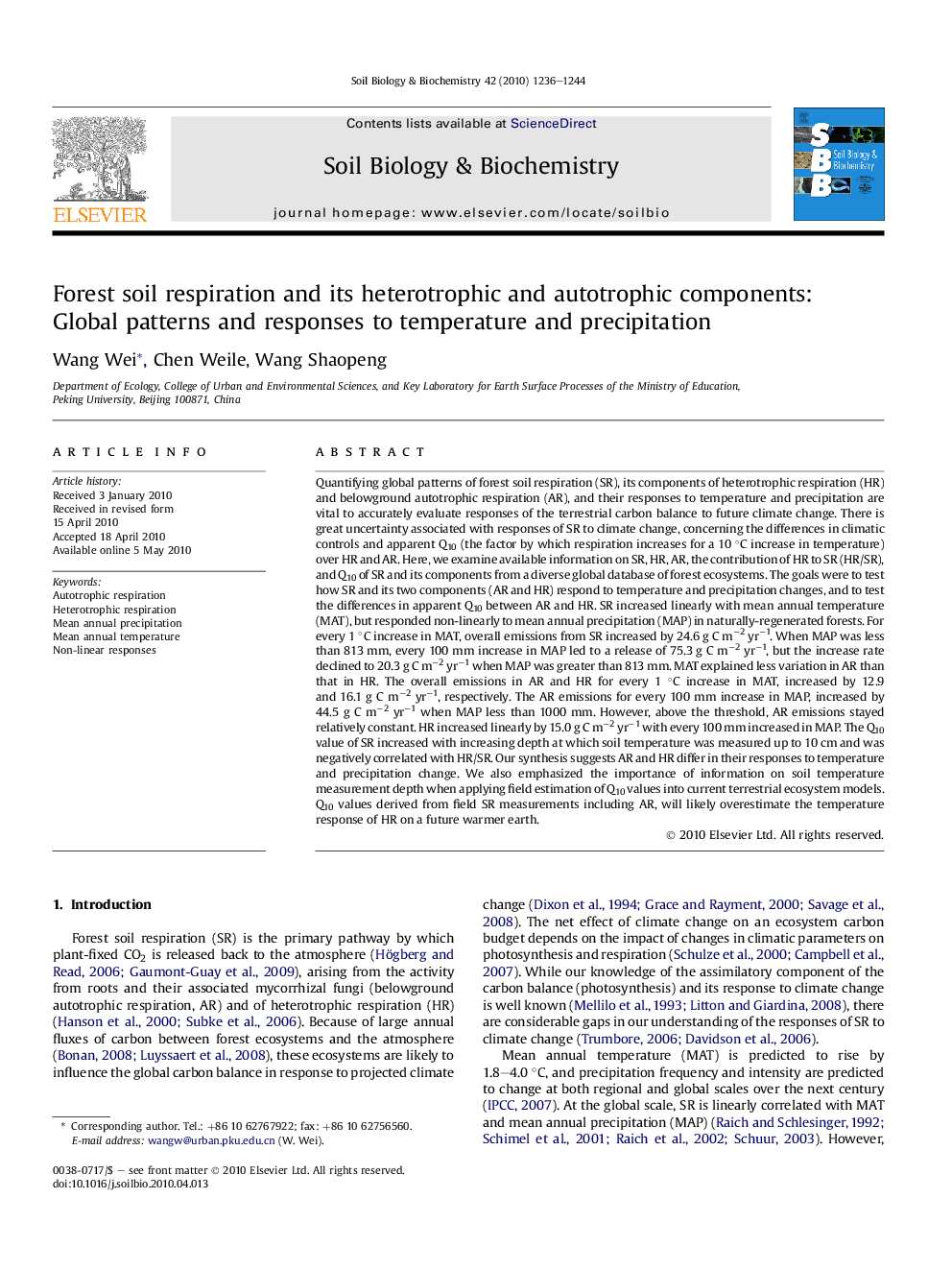| کد مقاله | کد نشریه | سال انتشار | مقاله انگلیسی | نسخه تمام متن |
|---|---|---|---|---|
| 2026093 | 1070019 | 2010 | 9 صفحه PDF | دانلود رایگان |
عنوان انگلیسی مقاله ISI
Forest soil respiration and its heterotrophic and autotrophic components: Global patterns and responses to temperature and precipitation
دانلود مقاله + سفارش ترجمه
دانلود مقاله ISI انگلیسی
رایگان برای ایرانیان
کلمات کلیدی
موضوعات مرتبط
علوم زیستی و بیوفناوری
علوم کشاورزی و بیولوژیک
دانش خاک شناسی
پیش نمایش صفحه اول مقاله

چکیده انگلیسی
Quantifying global patterns of forest soil respiration (SR), its components of heterotrophic respiration (HR) and belowground autotrophic respiration (AR), and their responses to temperature and precipitation are vital to accurately evaluate responses of the terrestrial carbon balance to future climate change. There is great uncertainty associated with responses of SR to climate change, concerning the differences in climatic controls and apparent Q10 (the factor by which respiration increases for a 10 °C increase in temperature) over HR and AR. Here, we examine available information on SR, HR, AR, the contribution of HR to SR (HR/SR), and Q10 of SR and its components from a diverse global database of forest ecosystems. The goals were to test how SR and its two components (AR and HR) respond to temperature and precipitation changes, and to test the differences in apparent Q10 between AR and HR. SR increased linearly with mean annual temperature (MAT), but responded non-linearly to mean annual precipitation (MAP) in naturally-regenerated forests. For every 1 °C increase in MAT, overall emissions from SR increased by 24.6 g C mâ2 yrâ1. When MAP was less than 813 mm, every 100 mm increase in MAP led to a release of 75.3 g C mâ2 yrâ1, but the increase rate declined to 20.3 g C mâ2 yrâ1 when MAP was greater than 813 mm. MAT explained less variation in AR than that in HR. The overall emissions in AR and HR for every 1 °C increase in MAT, increased by 12.9 and 16.1 g C mâ2 yrâ1, respectively. The AR emissions for every 100 mm increase in MAP, increased by 44.5 g C mâ2 yrâ1 when MAP less than 1000 mm. However, above the threshold, AR emissions stayed relatively constant. HR increased linearly by 15.0 g C mâ2 yrâ1 with every 100 mm increased in MAP. The Q10 value of SR increased with increasing depth at which soil temperature was measured up to 10 cm and was negatively correlated with HR/SR. Our synthesis suggests AR and HR differ in their responses to temperature and precipitation change. We also emphasized the importance of information on soil temperature measurement depth when applying field estimation of Q10 values into current terrestrial ecosystem models. Q10 values derived from field SR measurements including AR, will likely overestimate the temperature response of HR on a future warmer earth.
ناشر
Database: Elsevier - ScienceDirect (ساینس دایرکت)
Journal: Soil Biology and Biochemistry - Volume 42, Issue 8, August 2010, Pages 1236-1244
Journal: Soil Biology and Biochemistry - Volume 42, Issue 8, August 2010, Pages 1236-1244
نویسندگان
Wang Wei, Chen Weile, Wang Shaopeng,